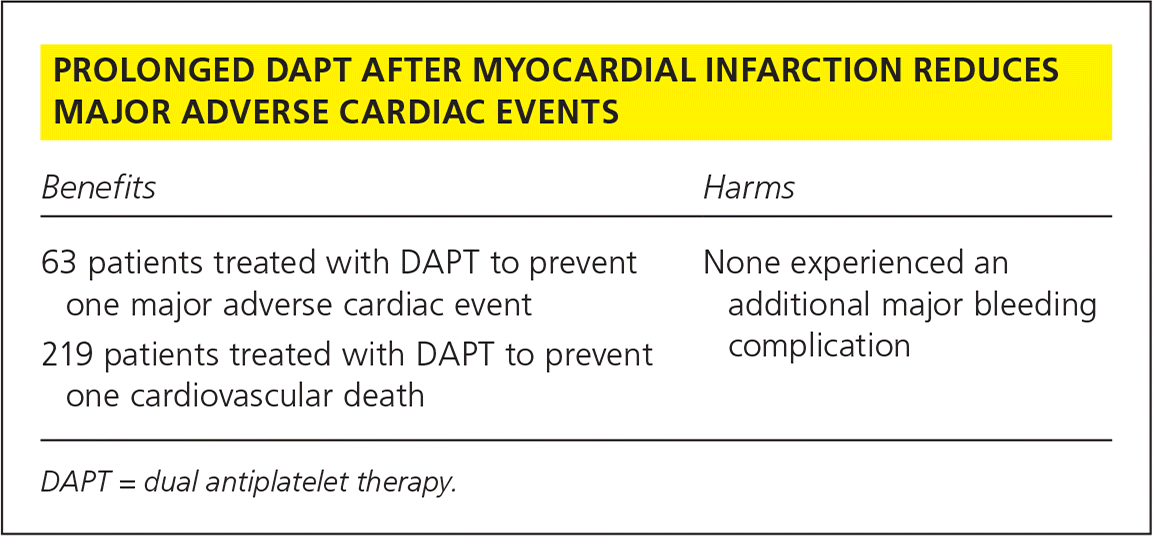
Am Fam Physician. 2017;96(7):online
Author disclosure: No relevant financial affiliations.


| Benefits | Harms |
|---|---|
| 63 patients treated with DAPT to prevent one major adverse cardiac event | None experienced an additional major bleeding complication |
| 219 patients treated with DAPT to prevent one cardiovascular death |
Details for This Review
Study Population: Adults with stent implantation following myocardial infarction (MI) and concurrent treatment with dual antiplatelet therapy (DAPT)—the combination of aspirin and a P2Y12 inhibitor
Efficacy End Points: Prevention of major adverse cardiac events, defined as cardiovascular and noncardiovascular death, MI, and stroke
Harm End Points: Major bleeding complications
Narrative: More than 1 million Americans are diagnosed with an MI every year.1 Risk of atherothrombosis increases significantly after an MI, with an increase in platelet activation that can last for years.1 Frequent placement of drug-eluting stents in these patients further increases the risk of thrombosis. Because of this increased thrombotic risk, DAPT is used for long-term secondary prevention of major cardiac events.2–4 The duration of DAPT has been debated over the past few years. Prolonged (more than 12 months) DAPT has been shown to increase mortality in patients with drug-eluting stents despite a reduced rate of MI and stent thrombosis.5 However, recent studies suggest that the use of prolonged DAPT after an MI, regardless of stent placement or type, improves cardiovascular mortality without a significant increase in bleeding risk.5
A 2016 meta-analysis, including three randomized controlled trials with a total of 21,534 patients post-MI, compared those who received DAPT for 12 months and those who received continuous treatment beyond one year, with mean follow-up of 2.5 years.5 Patients were randomized at least one year after their infarction with a minimum of two years follow-up. There were significantly lower rates of major cardiac events among those who used prolonged DAPT (number needed to treat [NNT] = 63). Of note, overall cardiovascular mortality was significantly improved (NNT = 219). Despite a numerical increase in complications with prolonged DAPT vs. non–prolonged DAPT, there was no statistical significance between treatment groups for major bleeding (N = 207 vs. 134) or fatal bleeding (N = 29 vs. 26). In patients who are stable one year post-MI, prolonged use of DAPT may be an effective treatment to decrease major cardiac events and cardiovascular mortality.
Caveats: Despite the evidence to support the use of prolonged DAPT in stable patients one year after an MI, there is still some debate as to the clinical relevance of these data. The American College of Cardiology and American Heart Association summarize the data as “moderately strong evidence of reduced cardiovascular events at the expense of increased bleeding.”4 This statement can be misleading because although it is based on a 2015 meta-analysis that shows a statistically significant increase in major bleeding (number needed to harm = 132), there was a nonsignificant increase in fatal bleeding. Additionally, this study demonstrated a reduction in cardiovascular death (NNT = 380) and no increase in noncardiovascular death or all-cause mortality.2 The data for this study come from the same randomized controlled trials in the 2016 meta-analysis with the addition of three additional trials (11,901 additional patients). These trials are not specifically discussed in the 2016 meta-analysis; however, it does point out that five articles were excluded because of incomplete data or nonrelevance.
The 2016 meta-analysis is limited by its lack of access to sufficient patient demographics to identify specific subgroups with higher therapy benefit or increased risk of harm. Additionally, it does not account for the presence or type of stents that patients may have received over the course of the study.
Copyright 2017 The NNT Group (theNNT.com). Used with permission.
This series is coordinated by Dean A. Seehusen, MD, MPH, AFP Contributing Editor, and Daniel Runde, MD, from the NNT Group.
A collection of Medicine by the Numbers published in AFP is available at https://www.aafp.org/afp/mbtn.
This review is available from the NNT Group at http://www.thennt.com/nnt/prolonged-dual-antiplatelet-therapy-mi-reduces-major-adverse-cardiac-events/.
